Thermophysical Properties of Sawdust and Coconut Coir Dust Incorporated Unfired Clay Blocks
Abstract
:1. Introduction
Research Significance
2. Materials and Methods
2.1. Materials
2.2. Testing Methods
2.2.1. Thermophysical Properties of Individual Samples
2.2.2. Thermal Properties of Wall Samples
3. Results and Discussions
3.1. Thermophysical Properties of Individual Samples
3.2. Thermal Properties of Wall Samples
4. Conclusions
- The presence of more waste content in the mixture decreased the density and consequently lowered the thermal conductivity of the samples. Based on the fact that coconut coir dust particles are lighter than sawdust particles, samples reinforced with coconut coir dust provided better thermal insulation than those reinforced with sawdust. When compared to the reference sample, the addition of coconut coir dust and sawdust resulted in a decrease of about 26% and 22% in density, as well as 46% and 43% in thermal conductivity, respectively.
- Moreover, waste inclusion contributed to lowering the volumetric heat capacity, thermal diffusivity, and thermal effusivity, while increasing the specific heat capacity of the samples.
- Furthermore, the wall made of 7.5% coconut coir dust had the best thermal performance, which may be attributed to the lightweight nature of the samples. Lightweight samples contain more air voids, which reduces the amount of heat transfer from hot to cold environments. The coconut coir dust and sawdust sample walls outperformed the reference sample wall in terms of thermal resistance, with an improvement of around 48% and 35%, respectively.
- Considering the thermal performance, it can be concluded that both types of agro-waste incorporation enhanced the overall thermal properties of the produced unfired clay blocks.
Author Contributions
Funding
Data Availability Statement
Acknowledgments
Conflicts of Interest
References
- Rodriguez, C.M.; D’Alessandro, M. Indoor thermal comfort review: The tropics as the next frontier. Urban Clim. 2019, 29, 100488. [Google Scholar] [CrossRef]
- Stocker, T.F.; Dahe, Q.; Plattner, G.K.; Tignor, M. IPCC workshop on regional climate projections and their use in impacts and risk analysis studies. In Workshop Report; Intergovernmental Panel on Climate Change: Bern, Switzerland, 2015; p. 18. [Google Scholar]
- Lundgren-Kownacki, K.; Hornyanszky, E.D.; Chu, T.A.; Olsson, J.A.; Becker, P. Challenges of using air conditioning in an increasingly hot climate. Int. J. Biometeorol. 2018, 62, 401–412. [Google Scholar] [CrossRef] [PubMed] [Green Version]
- Latha, P.K.; Darshana, Y.; Venugopal, V. Role of building material in thermal comfort in tropical climates—A review. J. Build. Eng. 2015, 3, 104–113. [Google Scholar] [CrossRef]
- Hashemi, A. Effects of thermal insulation on thermal comfort in low-income tropical housing. Energy Procedia 2017, 134, 815–824. [Google Scholar] [CrossRef] [Green Version]
- Zune, M.; Rodrigues, L.; Gillott, M. Vernacular passive design in Myanmar housing for thermal comfort. Sustain. Cities Soc. 2020, 54, 101992. [Google Scholar] [CrossRef]
- Aflaki, A.; Mahyuddin, N.; Mahmoud, Z.A.C.; Baharum, M.R. A review on natural ventilation applications through building façade components and ventilation openings in tropical climates. Energy Build. 2015, 101, 153–162. [Google Scholar] [CrossRef]
- Tatarestaghi, F.; Ismail, M.A.; Ishak, N.H. A comparative study of passive design features/elements in Malaysia and passive house criteria in the tropics. J. Des. Built Environ. 2018, 18, 15–25. [Google Scholar] [CrossRef]
- Shuhaimi, N.D.A.M.; Zaid, S.M.; Esfandiari, M.; Lou, E.; Mahyuddin, N. The impact of vertical greenery system on building thermal performance in tropical climates. J. Build. Eng. 2022, 45, 103429. [Google Scholar] [CrossRef]
- Emmanuel, R. An analysis of the bio-climatic effects of roof cover of domestic buildings in the equatorial tropics. Archit. Sci. Rev. 2002, 45, 117–124. [Google Scholar] [CrossRef]
- Bimaganbetova, M.; Memon, S.A.; Sheriyev, A. Performance evaluation of phase change materials suitable for cities representing the whole tropical savanna climate region. Renew. Energy 2020, 148, 402–416. [Google Scholar] [CrossRef]
- De Waal, H.B. New recommendations for building in tropical climates. Build. Environ. 1993, 28, 271–285. [Google Scholar] [CrossRef]
- Soubdhan, T.; Feuillard, T.; Bade, F. Experimental evaluation of insulation material in roofing system under tropical climate. Sol. Energy 2005, 79, 311–320. [Google Scholar] [CrossRef]
- Auroville Earth Institute. Building with Earth, Technique Overview. Available online: http://www.earth-auroville.com/world_techniques_introduction_en.php (accessed on 20 May 2022).
- Adegun, O.B.; Adedeji, Y.M.D. Review of economic and environmental benefits of earthen materials for housing in Africa. Front. Archit. Res. 2017, 6, 519–528. [Google Scholar] [CrossRef]
- Sheweka, S. Using mud bricks as a temporary solution for Gaza reconstruction. Energy Procedia 2011, 6, 236–240. [Google Scholar] [CrossRef] [Green Version]
- El Fgaier, F.; Lafhaj, Z.; Brachelet, F.; Antczak, E.; Chapiseau, C. Thermal performance of unfired clay bricks used in construction in the north of France: Case study. Case Stud. Constr. Mater. 2015, 3, 102–111. [Google Scholar] [CrossRef]
- Elias-Ozkan, S.T.; Summers, F.; Surmeli, N.; Yannas, S. A comparative study of the thermal performance of building materials. In Proceedings of the PLEA2006—The 23rd Conference on Passive and Low Energy Architecture, Geneva, Switzerland, 6–8 September 2006. [Google Scholar]
- Araya-Letelier, G.; Concha-Riedel, J.; Antico, F.C.; Sandoval, C. Experimental mechanical-damage assessment of earthen mixes reinforced with micro polypropylene fibers. Constr. Build. Mater. 2019, 198, 762–776. [Google Scholar] [CrossRef]
- Kulshreshtha, Y.; Mota, N.J.A.; Jagadish, K.S.; Bredenoord, J.; Vardon, P.J.; Van Loosdrecht, M.C.M.; Jonkers, H.M. The potential and current status of earthen material for low-cost housing in rural India. Constr. Build. Mater. 2020, 247, 118615. [Google Scholar] [CrossRef]
- Prusinski, J.R.; Bhattacharja, S. Effectiveness of Portland cement and lime in stabilizing clay soils. Transp. Res. Rec. 1999, 1652, 215–227. [Google Scholar] [CrossRef]
- Nagaraj, H.B.; Sravan, M.V.; Arun, T.G.; Jagadish, K.S. Role of lime with cement in long-term strength of Compressed Stabilized Earth Blocks. Int. J. Sustain. Built Environ. 2014, 3, 54–61. [Google Scholar] [CrossRef] [Green Version]
- Ouedraogo, K.A.J.; Aubert, J.E.; Tribout, C.; Escadeillas, G. Is stabilization of earth bricks using low cement or lime contents relevant? Constr. Build. Mater. 2020, 236, 117578. [Google Scholar] [CrossRef]
- Agamuthu, P. Challenges and opportunities in agro-waste management: An Asian perspective. In Proceedings of the Inaugural Meeting of First Regional 3R Forum in Asia, Tokyo, Japan, 11–12 November 2009. [Google Scholar]
- Tahir, T.A.; Hamid, F.S. Vermicomposting of two types of coconut wastes employing Eudrilus eugeniae: A comparative study. Int. J. Recycl. Org. Waste Agric. 2012, 1, 7. [Google Scholar] [CrossRef] [Green Version]
- Wang, B.; Dong, F.; Chen, M.; Zhu, J.; Tan, J.; Fu, X.; Wang, Y.; Chen, S. Advances in recycling and utilization of agricultural wastes in China: Based on environmental risk, crucial pathways, influencing factors, policy mechanism. Procedia Environ. Sci. 2016, 31, 12–17. [Google Scholar] [CrossRef] [Green Version]
- Maji, S.; Dwivedi, D.H.; Singh, N.; Kishor, S.; Gond, M. Agricultural waste: Its impact on environment and management approaches. In Emerging Eco-Friendly Green Technologies for Wastewater Treatment; Bharagava, R.N., Ed.; Springer: Singapore, 2020; Volume 18, pp. 329–351. [Google Scholar]
- Madurwar, M.V.; Ralegaonkar, R.V.; Mandavgane, S.A. Application of agro-waste for sustainable construction materials: A review. Constr. Build. Mater. 2013, 38, 872–878. [Google Scholar] [CrossRef]
- Liuzzi, S.; Sanarica, S.; Stefanizzi, P. Use of agro-wastes in building materials in the Mediterranean area: A review. Energy Procedia 2017, 126, 242–249. [Google Scholar] [CrossRef]
- Tawasil, D.N.B.; Aminudin, E.; Abdul Shukor Lim, N.H.; Nik Soh, N.M.Z.; Leng, P.C.; Ling, G.H.T.; Ahmad, M.H. Coconut fibre and sawdust as green building materials: A laboratory assessment on physical and mechanical properties of particleboards. Buildings 2021, 11, 256. [Google Scholar] [CrossRef]
- Hebbar, K.B.; Abhin, P.S.; Jose, V.S.; Neethu, P.; Santhosh, A.; Shil, S.; Prasad, P.V.V. Predicting the Potential Suitable Climate for Coconut (Cocos nucifera L.) Cultivation in India under Climate Change Scenarios Using the MaxEnt Model. Plants 2022, 11, 731. [Google Scholar] [CrossRef]
- Antwi-Boasiako, C.; Ofosuhene, L.; Boadu, K.B. Suitability of sawdust from three tropical timbers for wood-cement composites. J. Sustain. For. 2018, 37, 414–428. [Google Scholar] [CrossRef] [Green Version]
- Mwango, A.; Kambole, C. Engineering characteristics and potential increased utilisation of sawdust composites in construction—A review. J. Build. Constr. Plan. Res. 2019, 7, 59–88. [Google Scholar] [CrossRef] [Green Version]
- Wang, B.; Yan, L.; Kasal, B. A review of coir fibre and coir fibre reinforced cement-based composite materials (2000–2021). J. Clean. Prod. 2022, 338, 130676. [Google Scholar] [CrossRef]
- Ahmad, J.; Majdi, A.; Al-Fakih, A.; Deifalla, A.F.; Althoey, F.; El Ouni, M.H.; El-Shorbagy, M.A. Mechanical and Durability Performance of Coconut Fiber Reinforced Concrete: A State-of-the-Art Review. Materials 2022, 15, 3601. [Google Scholar] [CrossRef]
- Khedari, J.; Watsanasathaporn, P.; Hirunlabh, J. Development of fibre-based soil–cement block with low thermal conductivity. Cem. Concr. Compos. 2005, 27, 111–116. [Google Scholar] [CrossRef]
- Thanushan, K.; Yogananth, Y.; Sangeeth, P.; Coonghe, J.G.; Sathiparan, N. Strength and Durability Characteristics of Coconut Fibre Reinforced Earth Cement Blocks. J. Nat. Fibers 2021, 18, 773–788. [Google Scholar] [CrossRef]
- Thanushan, K.; Sathiparan, N. Mechanical performance and durability of banana fibre and coconut coir reinforced cement stabilized soil blocks. Materialia 2022, 21, 101309. [Google Scholar] [CrossRef]
- Danso, H.; Martinson, B.; Ali, M.; Mant, C. Performance characteristics of enhanced soil blocks: A quantitative review. Build. Res. Inf. 2015, 43, 253–262. [Google Scholar] [CrossRef] [Green Version]
- Sangma, S.; Pohti, L.; Tripura, D.D. Size Effect of Fiber on Mechanical Properties of Mud Earth Blocks. In Recycled Waste Materials; Agnihotri, A.K., Reddy, K.R., Bansal, A., Eds.; Springer: Berlin/Heidelberg, Germany, 2019; pp. 119–125. [Google Scholar]
- Purnomo, H.; Arini, S.W. Experimental Evaluation of Three Different Humidity Conditions to Physical and Mechanical Properties of Three Different Mixtures of Unfired Soil Bricks. Makara J. Technol. 2019, 23, 92–102. [Google Scholar] [CrossRef] [Green Version]
- Demir, I. Effect of organic residues addition on the technological properties of clay bricks. Waste Manag. 2008, 28, 622–627. [Google Scholar] [CrossRef]
- Ouattara, S.; Boffoue, M.O.; Assande, A.A.; Kouadio, K.C.; Kouakou, C.H.; Emeruwa, E.; Pasres. Use of Vegetable Fibers as Reinforcement in the Structure of Compressed Ground Bricks: Influence of Sawdust on the Rheological Properties of Compressed Clay Brick. Am. J. Mater. Sci. Eng. 2016, 4, 13–19. [Google Scholar]
- Vilane, B.R.T. Assessment of stabilisation of adobes by confined compression tests. Biosyst. Eng. 2010, 106, 551–558. [Google Scholar] [CrossRef]
- Jokhio, G.A.; Mohsin, S.M.S.; Gul, Y. Two-fold sustainability-Adobe with sawdust as partial sand replacement. IOP Conf. Ser. Mater. Sci. Eng. 2018, 342, 012069. [Google Scholar] [CrossRef]
- Ganga, G.; Nsongo, T.; Elenga, H.; Mabiala, B.; Tatsiete, T.T. Effect of incorporation of chips and wood dust mahogany on mechanical and acoustic behavior of brick clay. J. Build. Constr. Plan. Res. 2014, 2, 198–208. [Google Scholar]
- Tatane, M.; Akhzouz, H.; Elminor, H.; Feddaoui, M.B. Thermal, Mechanical and Physical Behavior of Compressed Earth Blocks Loads by Natural Wastes. Int. J. Civ. Eng. Technol. 2018, 9, 1353–1368. [Google Scholar]
- De Castrillo, M.C.; Ioannou, I.; Philokyprou, M. Reproduction of traditional adobes using varying percentage contents of straw and sawdust. Constr. Build. Mater. 2021, 294, 123516. [Google Scholar] [CrossRef]
- Charai, M.; Sghiouri, H.; Mezrhab, A.; Karkri, M.; Elhammouti, K.; Nasri, H. Thermal performance and characterization of a sawdust-clay composite material. Procedia Manuf. 2020, 46, 690–697. [Google Scholar] [CrossRef]
- Udawattha, C.; Halwatura, R. Thermal performance and structural cooling analysis of brick, cement block, and mud concrete block. Adv. Build. Energy Res. 2016, 12, 150–163. [Google Scholar] [CrossRef]
- ASTM D698; Standard Test Methods for Laboratory Compaction Characteristics of Soil Using Standard Effort (12,400 ft-lbf/ft3 (600 kN-m/m3)). ASTM International: West Conshohocken, PA, USA, 2012.
- BS 1377-2; Methods of Test for Soils for Civil Engineering Purposes, Part 2: Classification Tests. British Standards Institution: London, UK, 1990.
- BS EN 771-1; Specification for Masonry Units. Part 1: Clay Masonry Units. British Standards Institution: London, UK, 2003.
- Vosteen, H.D.; Schellschmidt, R. Influence of temperature on thermal conductivity, thermal capacity and thermal diffusivity for different types of rock. Phys. Chem. Earth Parts A/B/C 2003, 28, 499–509. [Google Scholar] [CrossRef]
- BS EN ISO 6946; Building Components and Building Elements—Thermal Resistance and Thermal Transmittance—Calculation methods. British Standards Institution: London, UK, 2017.
- Gaspar, K.; Casals, M.; Gangolells, M. A comparison of standardized calculation methods for in situ measurements of façades U-value. Energy Build. 2016, 130, 592–599. [Google Scholar] [CrossRef]
- Gaspar, K.; Casals, M.; Gangolells, M. Review of criteria for determining HFM minimum test duration. Energy Build. 2018, 176, 360–370. [Google Scholar] [CrossRef]
- Choi, D.S.; Ko, M.J. Analysis of Convergence Characteristics of Average Method Regulated by ISO 9869-1 for Evaluating In Situ Thermal Resistance and Thermal Transmittance of Opaque Exterior Walls. Energies 2019, 12, 1989. [Google Scholar] [CrossRef] [Green Version]
- BS ISO 9869-1; Thermal Insulation—Building Elements—In-Situ Measurement of Thermal Resistance and Thermal Transmittance—Part 1: Heat Flow Meter Method. British Standards Institution: London, UK, 2014.
- Gaspar, K.; Casals, M.; Gangolells, M. In situ measurement of façades with a low U-value: Avoiding deviations. Energy Build. 2018, 170, 61–73. [Google Scholar] [CrossRef]
- Soares, N.; Martins, C.; Gonçalves, M.; Santos, P.; Da Silva, L.S.; Costa, J.J. Laboratory and in-situ non-destructive methods to evaluate the thermal transmittance and behavior of walls, windows, and construction elements with innovative materials: A review. Energy Build. 2019, 182, 88–110. [Google Scholar] [CrossRef]
- Zhao, X.; Mofid, S.A.; Al Hulayel, M.R.; Saxe, G.W.; Jelle, B.P.; Yang, R. Reduced-scale hot box method for thermal characterization of window insulation materials. Appl. Therm. Eng. 2019, 160, 114026. [Google Scholar] [CrossRef]
- Asdrubali, F.; Baldinelli, G. Thermal transmittance measurements with the hot box method: Calibration, experimental procedures, and uncertainty analyses of three different approaches. Energy Build. 2011, 43, 1618–1626. [Google Scholar] [CrossRef]
- Lu, X.; Memari, A.M. Comparative study of Hot Box Test Method using laboratory evaluation of thermal properties of a given building envelope system type. Energy Build. 2018, 178, 130–139. [Google Scholar] [CrossRef]
- Lu, X.; Memari, A.M. Comparison of the Experimental Measurement Methods for Building Envelope Thermal Transmittance. Buildings 2022, 12, 282. [Google Scholar] [CrossRef]
- Buratti, C.; Belloni, E.; Lunghi, L.; Borri, A.; Castori, G.; Corradi, M. Mechanical characterization and thermal conductivity measurements using of a new ‘small hot-box’ apparatus: Innovative insulating reinforced coatings analysis. J. Build. Eng. 2016, 7, 63–70. [Google Scholar] [CrossRef]
- Meng, X.; Luo, T.; Gao, Y.; Zhang, L.; Shen, Q.; Long, E. A new simple method to measure wall thermal transmittance in situ and its adaptability analysis. Appl. Therm. Eng. 2017, 122, 747–757. [Google Scholar] [CrossRef]
- Laborel-Préneron, A.; Magniont, C.; Aubert, J.E. Hygrothermal properties of unfired earth bricks: Effect of barley straw, hemp shiv and corn cob addition. Energy Build. 2018, 178, 265–278. [Google Scholar] [CrossRef]
- Laborel-Preneron, A.; Aubert, J.E.; Magniont, C.; Tribout, C.; Bertron, A. Plant aggregates and fibers in earth construction materials: A review. Constr. Build. Mater. 2016, 111, 719–734. [Google Scholar] [CrossRef]
- Jannat, N.; Hussien, A.; Abdullah, B.; Cotgrave, A. Application of agro and non-agro waste materials for unfired earth blocks construction: A review. Constr. Build. Mater. 2020, 254, 119346. [Google Scholar] [CrossRef]
- Jannat, N.; Al-Mufti, R.L.; Hussien, A.; Abdullah, B.; Cotgrave, A. Influences of agro-wastes on the physico-mechanical and durability properties of unfired clay blocks. Constr. Build. Mater. 2022, 318, 126011. [Google Scholar] [CrossRef]
- Babé, C.; Kidmo, D.K.; Tom, A.; Mvondo, R.R.N.; Kola, B.; Djongyang, N. Effect of neem (Azadirachta Indica) fibers on mechanical, thermal and durability properties of adobe bricks. Energy Rep. 2021, 7, 686–698. [Google Scholar] [CrossRef]
- Kazmi, S.M.S.; Munir, M.J.; Patnaikuni, I.; Wu, Y.F.; Fawad, U. Thermal performance enhancement of eco-friendly bricks incorporating agro-wastes. Energy Build. 2018, 158, 1117–1129. [Google Scholar] [CrossRef]
- Tornay, N.; Schoetter, R.; Bonhomme, M.; Faraut, S.; Masson, V. GENIUS: A methodology to define a detailed description of buildings for urban climate and building energy consumption simulations. Urban Clim. 2017, 20, 75–93. [Google Scholar] [CrossRef]
- Stapulionienė, R.; Vaitkus, S.; Vėjelis, S.; Sankauskaitė, A. Investigation of thermal conductivity of natural fibres processed by different mechanical methods. Int. J. Precis. Eng. Manuf. 2016, 17, 1371–1381. [Google Scholar] [CrossRef]
- Pásztory, Z. An overview of factors influencing thermal conductivity of building insulation materials. J. Build. Eng. 2021, 44, 102604. [Google Scholar]
- Ouedraogo, M.; Dao, K.; Millogo, Y.; Aubert, J.E.; Messan, A.; Seynou, M.; Zerbo, L.; Gomina, M. Physical, thermal and mechanical properties of adobes stabilized with fonio (Digitaria exilis) straw. J. Build. Eng. 2019, 23, 250–258. [Google Scholar] [CrossRef]
- Raut, A.N.; Gomez, C.P. Development of thermally efficient fibre-based eco-friendly brick reusing locally available waste materials. Constr. Build. Mater. 2017, 133, 275–284. [Google Scholar] [CrossRef] [Green Version]
- Zhang, L.; Yang, L.; Jelle, B.P.; Wang, Y.; Gustavsen, A. Hygrothermal properties of compressed earthen bricks. Constr. Build. Mater. 2018, 162, 576–583. [Google Scholar] [CrossRef]
- Kandula, R.; Sanaka, S.P.; Prasad, A.V.R.; Reddy, K.H. Thermo-physical and Fire Properties of Natural Fiber Composites for Energy Saving Applications. J. Nat. Fibers 2022, 1–13. [Google Scholar] [CrossRef]
- Babé, C.; Kidmo, D.K.; Tom, A.; Mvondo, R.R.N.; Boum, R.B.E.; Djongyang, N. Thermomechanical characterization and durability of adobes reinforced with millet waste fibers (sorghum bicolor). Case Stud. Constr. Mater. 2020, 13, e00422. [Google Scholar] [CrossRef]
- Millogo, Y.; Morel, J.C.; Aubert, J.E.; Ghavami, K. Experimental analysis of Pressed Adobe Blocks reinforced with Hibiscus cannabinus fibers. Constr. Build. Mater. 2014, 52, 71–78. [Google Scholar] [CrossRef]
- Khoudja, D.; Taallah, B.; Izemmouren, O.; Aggoun, S.; Herihiri, O.; Guettala, A. Mechanical and thermophysical properties of raw earth bricks incorporating date palm waste. Constr. Build. Mater. 2021, 270, 121824. [Google Scholar] [CrossRef]
- Zeghari, K.; Gounni, A.; Louahlia, H.; Marion, M.; Boutouil, M.; Goodhew, S.; Streif, F. Novel Dual Walling Cob Building: Dynamic Thermal Performance. Energies 2021, 14, 7663. [Google Scholar] [CrossRef]
- Medjelekh, D.; Ulmet, L.; Abdou, S.; Dubois, F. A field study of thermal and hygric inertia and its effects on indoor thermal comfort: Characterization of travertine stone envelope. Build. Environ. 2016, 106, 57–77. [Google Scholar] [CrossRef]
- Lizana, J.; Chacartegui, R.; Barrios-Padura, A.; Valverde, J.M. Advances in thermal energy storage materials and their applications towards zero energy buildings: A critical review. Appl. Energy 2017, 203, 219–239. [Google Scholar] [CrossRef]
- Jeanjean, A.; Olives, R.; Py, X. Selection criteria of thermal mass materials for low-energy building construction applied to conventional and alternative materials. Energy Build. 2013, 63, 36–48. [Google Scholar] [CrossRef]
- Atiki, E.; Taallah, B.; Feia, S.; Almeasar, K.S.; Guettala, A. Effects of Incorporating Date Palm Waste as a Thermal Insulating Material on the Physical Properties and Mechanical Behavior of Compressed Earth Block. J. Nat. Fibers 2021, 1–18. [Google Scholar] [CrossRef]
- Bruno, A.W.; Gallipoli, D.; Perlot, C.; Kallel, H. Thermal performance of fired and unfired earth bricks walls. J. Build. Eng. 2020, 28, 101017. [Google Scholar] [CrossRef]
- Ojerinde, A. The Use of Rice Husk Ash (RHA) as Stabilizer in Compressed Earth Block (CEB) for Affordable Houses. Ph.D Thesis, Cardiff University, Cardiff, UK, 2020. [Google Scholar]
- Krstić, H.; Miličević, I.; Markulak, D.; Domazetović, M. Thermal Performance Assessment of a Wall Made of Lightweight Concrete Blocks with Recycled Brick and Ground Polystyrene. Buildings 2021, 11, 584. [Google Scholar] [CrossRef]
- Chowdhury, D.; Neogi, S. Thermal performance evaluation of traditional walls and roof used in tropical climate using guarded hot box. Constr. Build. Mater. 2019, 218, 73–89. [Google Scholar] [CrossRef]
- Callejas, I.J.A.; Durante, L.C.; de Oliveira, A.S. Thermal resistance and conductivity of recycled construction and demolition waste (RCDW) concrete blocks. REM Int. Eng. J. 2017, 70, 167–173. [Google Scholar] [CrossRef]
- Teixeira, E.R.; Machado, G.; de P. Junior, A.; Guarnier, C.; Fernandes, J.; Silva, S.M.; Mateus, R. Mechanical and thermal performance characterisation of compressed earth blocks. Energies 2020, 13, 2978. [Google Scholar] [CrossRef]
- Douzane, O.; Promis, G.; Roucoult, J.M.; Le, A.D.T.; Langlet, T. Hygrothermal performance of a straw bale building: In situ and laboratory investigations. J. Build. Eng. 2016, 8, 91–98. [Google Scholar] [CrossRef]
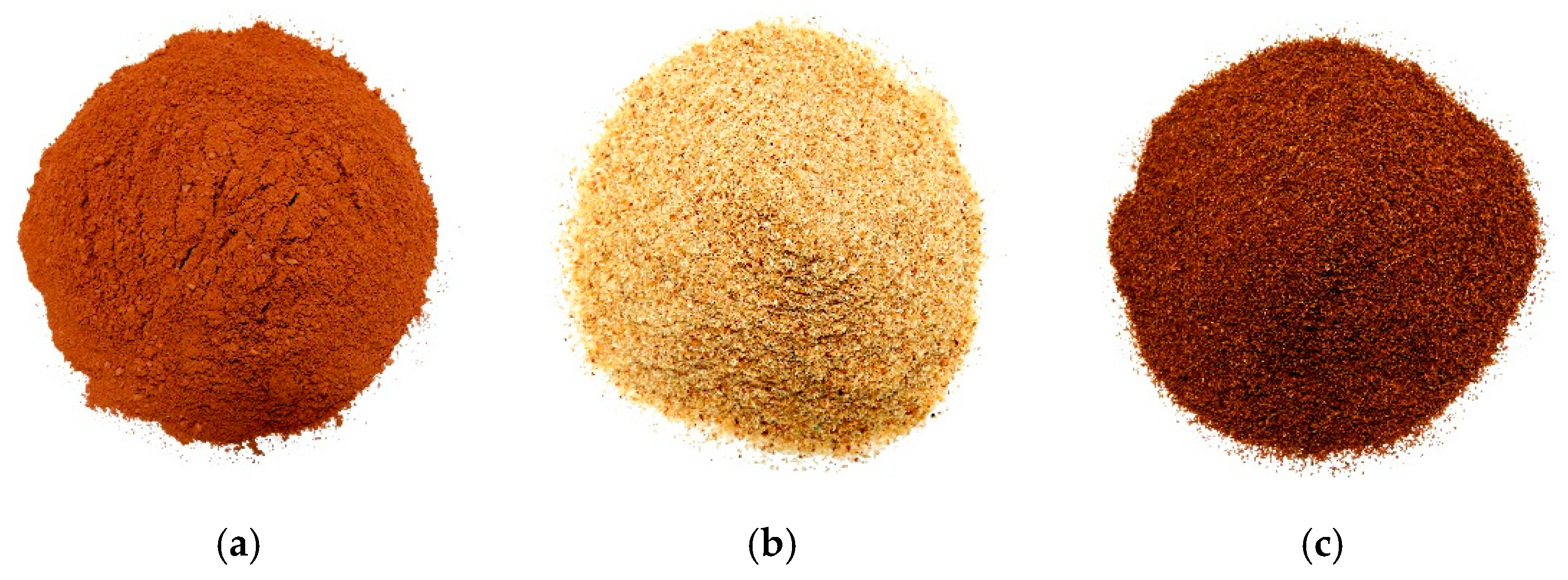
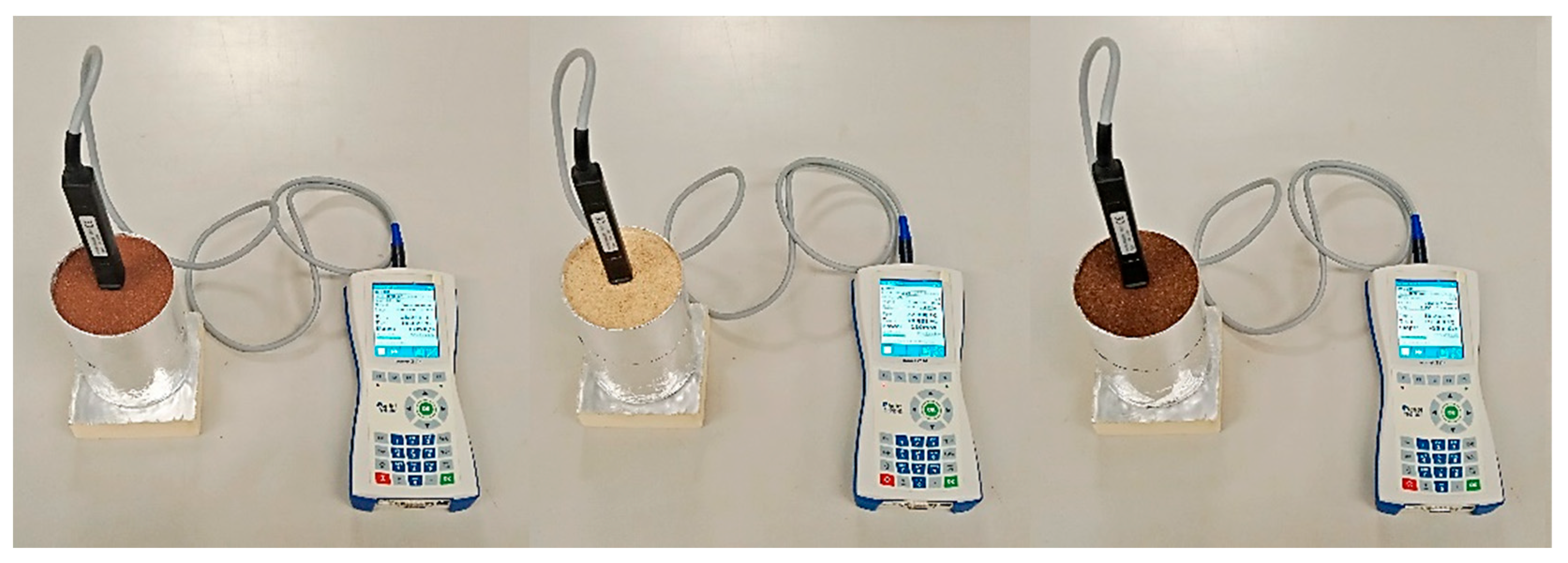
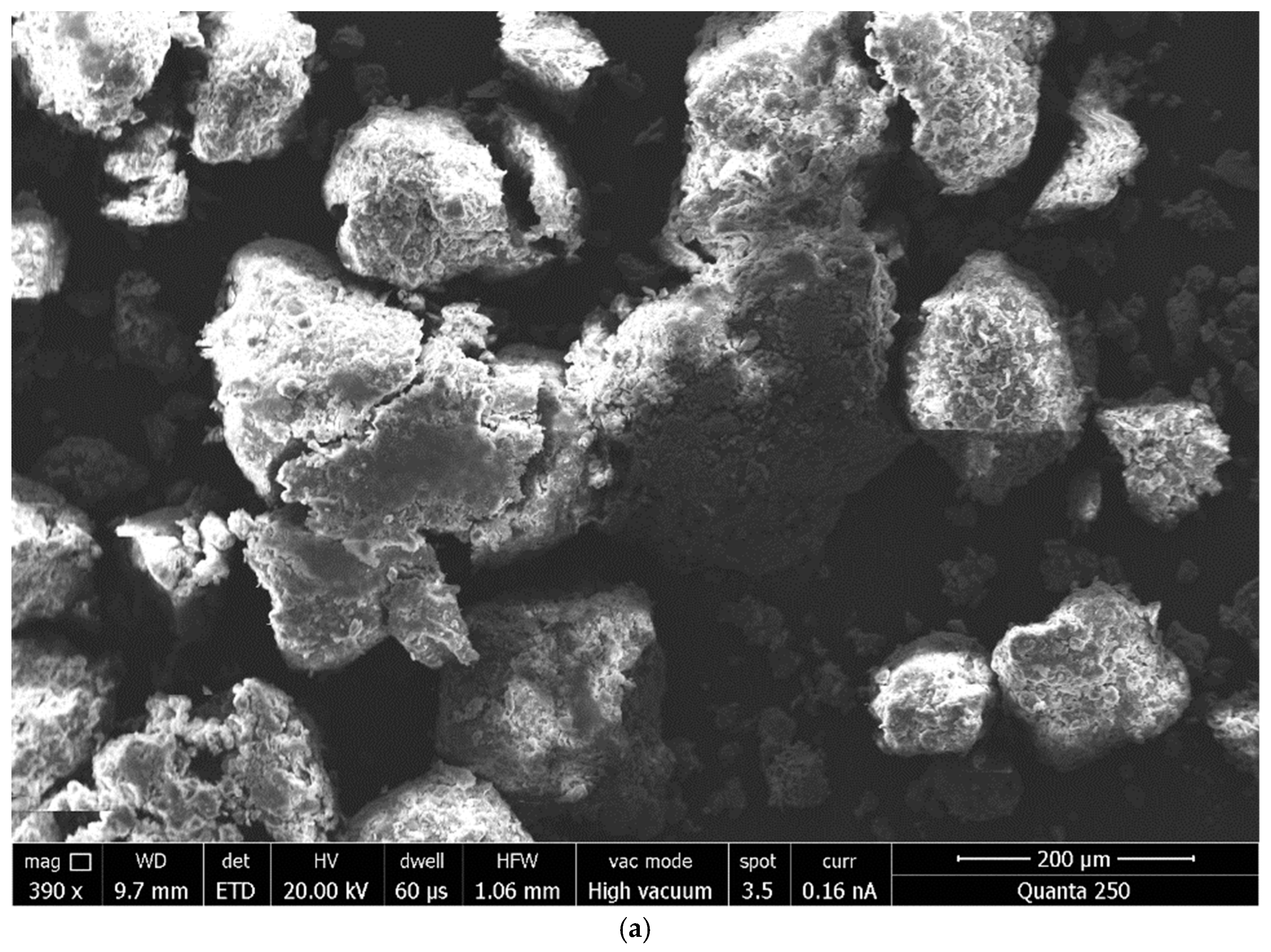

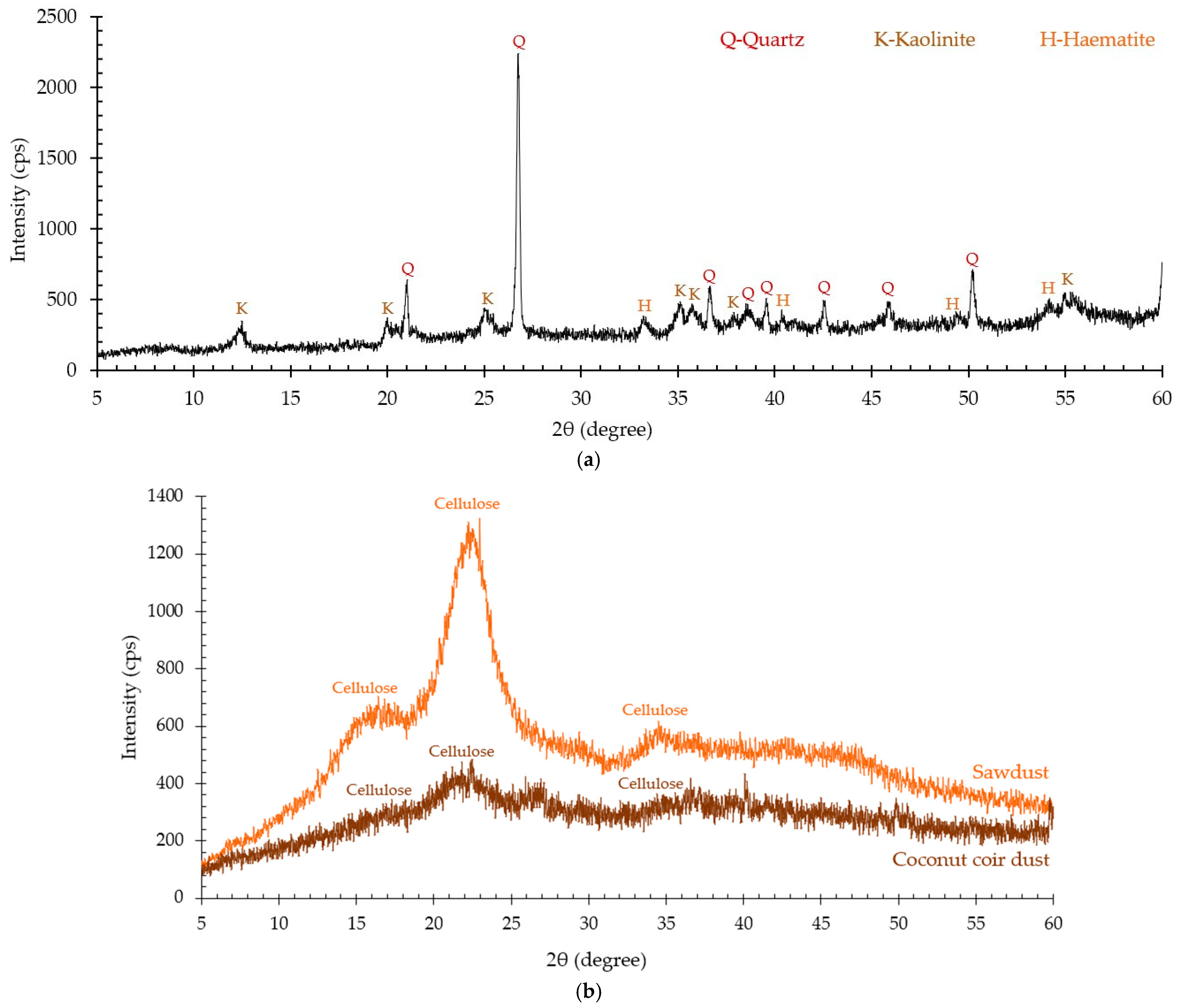



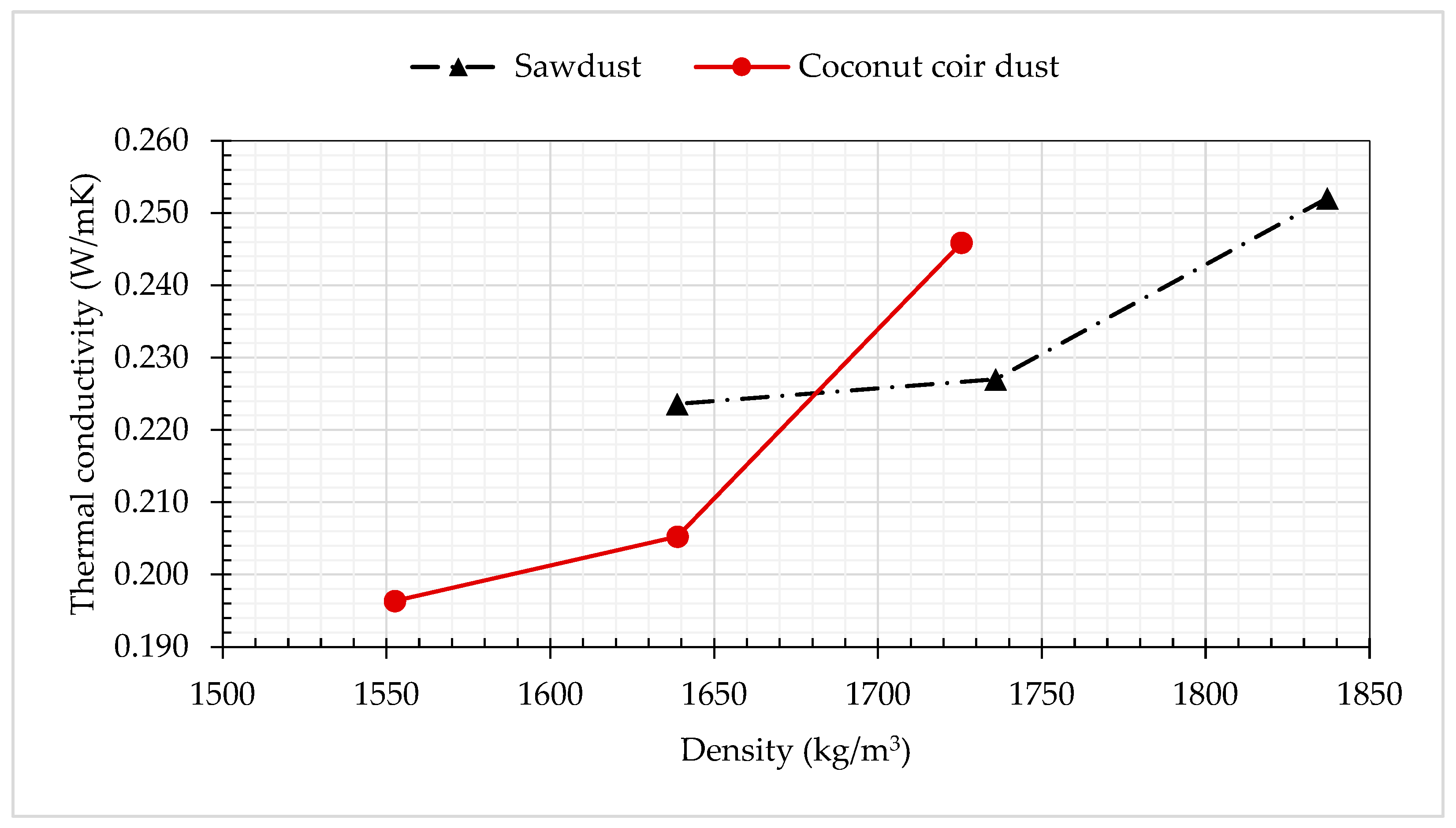


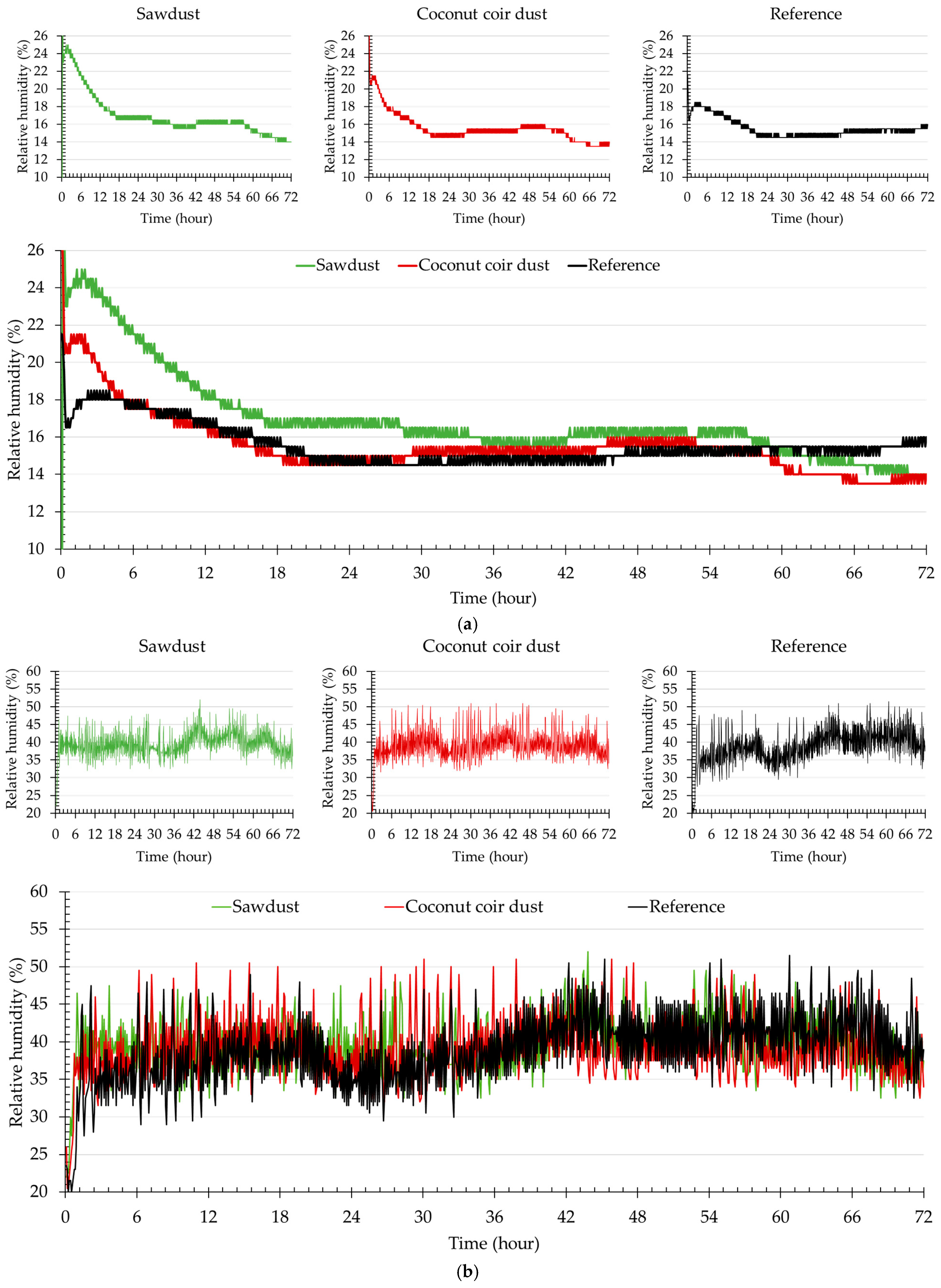

| Properties | Red Clay | Sawdust | Coconut Coir Dust |
|---|---|---|---|
| Density (kg/m3) | 1430 | 230 | 130 |
| Specific gravity | 2.32 | 1.14 | 0.61 |
| Thermal conductivity (W/mK) | 0.30 | 0.06 | 0.05 |
| Volumetric heat capacity (×106 J/m3K) | 1.29 | 0.24 | 0.21 |
| Specific heat capacity (J/kgK) | 902.80 | 1040.43 | 1583.08 |
| Porosity | 0.38 | 5.09 | 7.65 |
| Natural moisture content (%) | 6.47 | 5.02 | 5.62 |
| Water absorption after 24 h under water (%) | 27.57 | 127.66 | 195.16 |
| Colour | Red | Light brown | Brown |
| Elements | Weight (%) | ||
|---|---|---|---|
| Red Clay | Sawdust | Coconut Coir Dust | |
| SiO2 | 41.454 | 0.348 | 4.059 |
| Al2O3 | 15.214 | 0.390 | 1.206 |
| K2O | 1.636 | 0.340 | 3.942 |
| MgO | 5.114 | 0.408 | 0.767 |
| Fe2O3 | 8.104 | 0.186 | 1.184 |
| Na2O | 1.027 | 0.926 | 1.183 |
| TiO2 | 1.411 | 0.171 | 0.596 |
| CaO | 0.633 | 1.681 | 2.782 |
| SO3 | 0.047 | 0.049 | 0.275 |
| BaO | 0.216 | 0.074 | 0.089 |
| MnO | 0.040 | 0.026 | 0.013 |
| ZrO2 | 0.035 | 0.002 | 0.011 |
| P2O5 | 0.250 | 0.021 | 0.094 |
| SrO | 0.011 | 0.000 | 0.005 |
| CuO | 0.006 | 0.003 | 0.002 |
| ZnO | 0.007 | 0.004 | 0.006 |
| Y2O3 | 0.006 | 0.001 | 0.001 |
| F | 0.050 | 0.050 | 0.050 |
| Cl | 0.040 | 0.040 | 0.040 |
| Co2O3 | 0.007 | 0.002 | 0.001 |
| Rb2O | 0.004 | - | - |
| NiO | 0.003 | - | - |
| BaO | 0.097 | - | - |
| Cr2O3 | 0.016 | - | - |
| Br | - | - | 0.001 |
| CHO | 24.572 | 95.278 | 83.693 |
| Mix Designation of Samples | Red Clay (g) | Waste (%) | Waste (g) | ||
|---|---|---|---|---|---|
| Sawdust | Coconut Coir Dust | Sawdust | Coconut Coir Dust | ||
| R | 550 | 0 | 0 | 0 | 0 |
| S-2.5 | 550 | 2.5 | 0 | 13.75 | 0 |
| S-5 | 550 | 5 | 0 | 27.50 | 0 |
| S-7.5 | 550 | 7.5 | 0 | 41.25 | 0 |
| C-2.5 | 550 | 0 | 2.5 | 0 | 13.75 |
| C-5 | 550 | 0 | 5 | 0 | 27.50 |
| C-7.5 | 550 | 0 | 7.5 | 0 | 41.25 |
| Equipment | Model | Parameters | Values |
|---|---|---|---|
| Temperature sensor | K-type thermocouple | Accuracy (°C) | ±1.5 |
| Heat flux sensor | gSKIN-XB 26 9C | Range (kW/m²) | −150 to +150 |
| Sensitivity [μV/(W/m²)] | 1.5 | ||
| Calibration accuracy (%) | ±3 | ||
| Resolution (W/m²) | 0.41 | ||
| Temperature controller | EMKO ESM-3711-H | Accuracy (%) | ±1 |
| Data logger | Pico USB TC-08 | Voltage input range (mV) | ±70 |
| Temperature range (°C) | −270 to +1820 | ||
| Temperature accuracy (°C) | Sum of ±0.2% of reading and ±0.5 | ||
| Voltage accuracy (µV) | Sum of ±0.2% of reading and ±10 | ||
| Temperature and relative humidity data logger | EL-USB-2 RH/TEMP | Temperature range (°C) | −35 to +80 |
| Relative humidity range (%) | 0 to 100 | ||
| Temperature accuracy (°C) | ±0.5 | ||
| Relative humidity accuracy (%) | ±2.25 | ||
| Heating source | DIMPLEX ECOT1FT thermostatic tubular heater | Heat output (W) | 40 |
| Capacity (V) | 230–240 | ||
| Fan | 4″ portable USB fan | Capacity (V) | 5 |
| Sample ID | Density, ρ (kg/m3) | Thermal Conductivity, λ (W/mK) | Volumetric Heat Capacity, ρCp (×106 J/m3K) | Specific Heat Capacity, Cp (J/kgK) | Thermal Diffusivity, α (×10−6 m2/s) | Thermal Effusivity, τ (Ws1/2/m2K) |
|---|---|---|---|---|---|---|
| R | 2090.96 ± 2.55 (0.32) | 0.36 ± 0.02 (0.14) | 1.66 ± 0.25 (0.33) | 794.75 | 0.217 | 774.70 |
| S-2.5 | 1837.05 ± 2.36 (0.08) | 0.26 ± 0.01 (0.22) | 1.51 ± 0.23 (0.31) | 824.12 | 0.173 | 629.44 |
| S-5 | 1735.85 ± 2.35 (0.13) | 0.24 ± 0.01 (0.30) | 1.47 ± 0.22 (0.33) | 849.41 | 0.161 | 591.14 |
| S-7.5 | 1638.64 ± 2.34 (0.09) | 0.21 ± 0.01 (0.41) | 1.42 ± 0.21 (0.43) | 865.39 | 0.145 | 539.96 |
| C-2.5 | 1725.44 ± 2.54 (0.24) | 0.25 ± 0.01 (0.23) | 1.46 ± 0.22 (0.41) | 848.68 | 0.168 | 600.19 |
| C-5 | 1638.79 ± 2.56 (0.25) | 0.22 ± 0.01 (0.32) | 1.41 ± 0.21 (0.39) | 859.45 | 0.159 | 561.19 |
| C-7.5 | 1552.52 ± 2.59 (0.27) | 0.19 ± 0.01 (0.47) | 1.38 ± 0.21 (0.47) | 886.20 | 0.142 | 517.77 |
| Measurements | Wall ID | |||
|---|---|---|---|---|
| R | S-7.5 | C-7.5 | ||
| Average values (Last 24 h) | Thickness (mm) | 100 | 100 | 100 |
| Surface Temperature (hot side) (°C) | 37.32 | 37.40 | 36.46 | |
| Surface Temperature (cold side) (°C) | 13.44 | 13.32 | 13.42 | |
| Temperature Difference (°C) | 23.88 | 23.08 | 23.04 | |
| Heat Flux (W/m2) | 548.17 | 407.53 | 369.96 | |
| U-value (W/m2K) | 1.85 | 1.37 | 1.24 | |
| R-value (m2K/W) | 0.54 | 0.73 | 0.80 | |
Publisher’s Note: MDPI stays neutral with regard to jurisdictional claims in published maps and institutional affiliations. |
© 2022 by the authors. Licensee MDPI, Basel, Switzerland. This article is an open access article distributed under the terms and conditions of the Creative Commons Attribution (CC BY) license (https://creativecommons.org/licenses/by/4.0/).
Share and Cite
Jannat, N.; Cullen, J.; Abdullah, B.; Latif Al-Mufti, R.; Karyono, K. Thermophysical Properties of Sawdust and Coconut Coir Dust Incorporated Unfired Clay Blocks. Constr. Mater. 2022, 2, 234-257. https://doi.org/10.3390/constrmater2040016
Jannat N, Cullen J, Abdullah B, Latif Al-Mufti R, Karyono K. Thermophysical Properties of Sawdust and Coconut Coir Dust Incorporated Unfired Clay Blocks. Construction Materials. 2022; 2(4):234-257. https://doi.org/10.3390/constrmater2040016
Chicago/Turabian StyleJannat, Nusrat, Jeff Cullen, Badr Abdullah, Rafal Latif Al-Mufti, and Karyono Karyono. 2022. "Thermophysical Properties of Sawdust and Coconut Coir Dust Incorporated Unfired Clay Blocks" Construction Materials 2, no. 4: 234-257. https://doi.org/10.3390/constrmater2040016
APA StyleJannat, N., Cullen, J., Abdullah, B., Latif Al-Mufti, R., & Karyono, K. (2022). Thermophysical Properties of Sawdust and Coconut Coir Dust Incorporated Unfired Clay Blocks. Construction Materials, 2(4), 234-257. https://doi.org/10.3390/constrmater2040016







